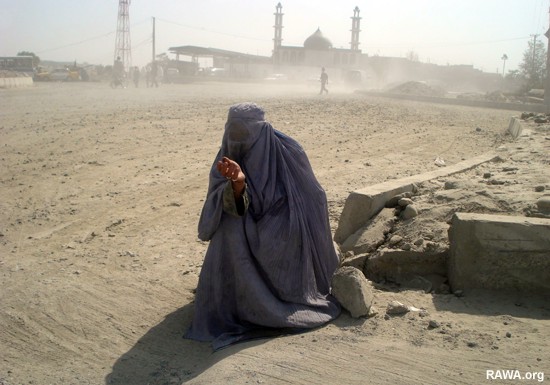KABUL - Knocking on the windows of cars stuck in traffic on Shar-e-Naw Street in Kabul, Zulaikha and her children beg for money to keep warm and feed themselves. Their daily routine starts at about 7am and ends at 6pm every day.
“Often we collect 100-150 Afghanis [US$ 2-3] a day,” she said, adding that it was barely enough for bread and tea.
Zulaikha lost her husband, Jamaluddin, in factional fighting between former Taliban and Northern Alliance forces in the northern outskirts of Kabul in 1999. She has three children - an 11-year-old son and two daughters aged eight and nine.
Over the past three years she has been living in a shack outside Kabul, for which she pays a monthly rent of $15.
“We have nobody to help us,” the widow said.
Afghanistan has one of the highest numbers of widows (proportionate to the total population) in the world, owing to the armed conflicts that have bedevilled the country for over two decades.
There are over 1.5 million widows out of an estimated 26.6 million people in Afghanistan, according to Beyond 9/11, a US-based nonprofit group that provides direct financial support to Afghan widows and their children. Some 50,000-70,000 widows live in Kabul alone, it says.
The government of Afghanistan does not have an accurate figure for the number of widows in the country, but some officials say there are more than 1.5 million.
Most widows illiterate
“The average age of an Afghan widow is just 35 years, and 94 percent of them are unable to read and write,” Deborah Zalesne, a board member of the Beyond 9/11 and a law professor at the City University of New York, told IRIN.
“About 90 percent of Afghan widows have children, and the average widow has more than four,” Zalesne added.
To survive many Afghan widows weave carpets, do tailoring, beg or even engage in prostitution.
In urban areas where women have better access to employment and other services than in conservative rural areas, an average working widow earns about $16 a month, experts estimate.
Shelter, food, earning a living and social protection are among the most pressing issues for widows, the Ministry of Women’s Affairs (MoWA) said.
During winter, when fuel and food costs increase, female-headed households become highly vulnerable.
Psychosocial difficulties
“Widowed women are also at greater risk of emotional problems and impaired psychosocial functioning than either married women or men, typically because of social exclusion, forced marriages, gender-based violence and lack of economic and educational opportunities,” said Zalesne.
“In Afghanistan’s patriarchal society, the death of a husband not only diminishes a woman’s economic independence but also damages her sense of social protection,” said Hussain Ali Moin, an official at MoWA.
Government, donors not doing enough
Women’s rights activists such as Soraya Subhrang, a member of Afghanistan Independent Human Rights Commission, have criticised the government and international donors for not doing enough to alleviate the plight of widows.
“Afghan women in general and widows in particular do not have a voice to express their problems and are also deprived of meaningful representation in public institutions,” Subhrang said.
Officials at the Ministry of Women’s Affairs also concede that Afghan widows often live in wretched conditions, and say more needs to be done to deal with their problems.
The interim-Afghanistan National Development Strategy (i-ANDS) has a noble aim: to reduce poverty among women by at least 20 percent and ensure that women make up at least 20 percent of all public bodies by 2010. However, there is a long way to go before the lives of widows like Zulaikha can be changed for the better, analysts say.




